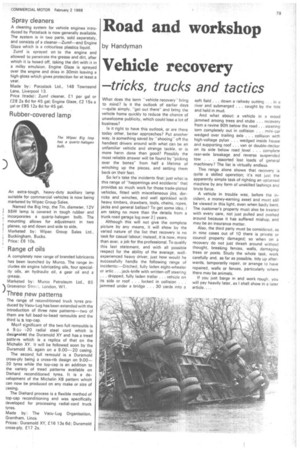Road and workshop Vehicle recovery
Page 81

If you've noticed an error in this article please click here to report it so we can fix it.
tricks, trucks and tactics
by Handyman What does the term "vehicle recovery" bring to mind? Is it the outlook of earlier days —quite simply, "get out there" and bring the vehicle home quickly to reduce the chance of unwelcome publicity, which could lose a lot of business?
Is it right to have this outlook, or are there today other, better approaches? Put another way, is something saved by -shooing" off the handiest drivers around with what can be an unfamiliar vehicle and strange tackle, or is more harm done than good? Possibly the most reliable answer will be found by "picking over the bones" from half a lifetime of winching up the pieces, and setting them back on their feet.
So let's take the incidents first: just what is this range of "happenings and accidents" that provides so much work for those trade-plated vehicles, fitted with miscellaneous jibs, derricks and winches, and well sprinkled with heavy timbers, drawbars, tools, chains, ropes, jacks and general ballast? To get some idea, I am taking no more than the details from a trunk road garage log over 2 years.
. Although this will not give the complete picture by any means, it will show by the varied nature of the list that recovery is no task for casual labour; instead, it is now, more than ever, a job for the professional. To qualify this last statement, and with all possible respect for the ability of the average, wellexperienced heavy driver, just how would he successfully handle the following range of incidents:--Ditched, fully laden eight-wheeler or artic . jack-knife with written-off steering . . . dropped, fully laden trailer . . . vehicle on its side or roof . . . locked in collision . . jammed under a bridge . . . 30 yards into a soft field . . . down a railway cutting . . . in a river and submerged . . . caught by the tide and held in mud.
And what about: a vehicle in a wood jammed among trees and stubs . . recovery from a ravine 90ft below the road .. . steering torn completely out in collision . . mini-car wedged over trailing axle . . . collision with high-voltage pylon . . . wedged inside house and supporting roof . . . van or double-decker on its side below road level . . complete rear-axle breakage and reverse suspended tow . . . assorted lost loads of general machinery? The list is virtually endless.
This range alone shows that recovery is quite a skilled operation; it's not just the apparently simple task of righting an upturned machine by any form of unskilled lashings and brute force.
A vehicle in trouble was, before the incident, a money-earning asset and must still be viewed in this light, even when badly bent. The customer's property must also be treated with every care, not just pulled and pushed around because it has suffered mishap, and may be an insurance matter.
Also, the third party must be considered, as in nine cases out of 10 there is private or council property damaged; so when on a recovery do not just thrash around without thought, breaking fences, walls, damaging trees or posts. Study the whole task, work carefully and, as far as possible, tidy up afterwards, temporarily repair, or arrange to have repaired, walls or fences, particularly where there may be animals, If you just barge in and work rough, you will pay heavily later, as I shall show in a later article....




































































































































































































